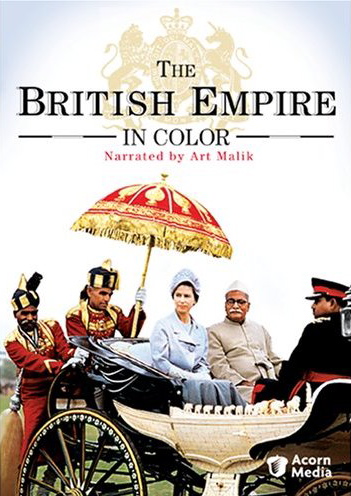| Release List | Reviews | Price Search | Shop | Newsletter | Forum | DVD Giveaways | Blu-Ray/ HD DVD | Advertise |
| Reviews & Columns |
|
Reviews DVD TV on DVD Blu-ray International DVDs Theatrical Reviews by Studio Video Games Features Collector Series DVDs Easter Egg Database Interviews DVD Talk TV DVD Talk Radio Feature Articles Columns Anime Talk DVD Savant HD Talk Horror DVDs Silent DVD
|
DVD Talk Forum |
|
|
| Resources |
|
DVD Price Search Customer Service #'s RCE Info Links |
|
Columns
|
 |
The British Empire in Color |

|
The British Empire in Color Acorn Media 2002 / Color / 1:33 flat full frame / 147 min. / Street Date April 29, 2008 / 24.99 Film Editor Stephen Moore Original Music Chris Elliott Produced by Lucy Carter, Stewart Binns, Adrian Wood |
This 2002 documentary for English television delivers its stated goods -- it contains 2.5 hours of rare color footage dating back to the early 1920s, much of it very interesting. It claims also to be a documentary on the waning decades of the British Empire, from the time when England ruled millions of colonial subjects worldwide to the 1997 return of Hong Kong back to China. The main source appears to be a great quantity of non-commercial color footage and even home movies, filmed under semi-professional conditions. The English hobbyists took their amateur filmmaking seriously, with the result that the non-pro coverage here is often as good as what appears to be unedited color scenes filmed by professionals. Videotape doesn't rear its ugly head until the 1980s.
Where the show doesn't work is as a documentary. The filmmakers openly state that their aim, as in earlier efforts (2000's Britain at War in Colour), was to build whatever show they could that the available footage would support. This means that, although the narration script is talking about India and we're seeing images from India, that there's often little connection between the two. The show's authorial point of view can also be highly prejudicial. Movies of English ladies enjoying garden parties in India are accompanied, Ken Burns-style, by un-attributed, dramatized speeches that characterize the colonials as snobs. The chosen readings make fun of the local swamis as 'dirty natives', that sort of thing. Surely that attitude was common in India, but the show doesn't add to our understanding of it. We almost believe that the broadcast backers of the show insisted on the PC statements to deflect potential public complaints over the sixty and seventy-year-old images of British dominance.
In general, the docu's three chapters (this must have been a 3-part miniseries) skip from continent to continent, showing conditions under the colonials. We see impressive pictures of Mohandas Gandhi, only to have a (presumed) vocal artist imitate him for more Ken Burns audio bites. Because the voices are never identified as recreations, the docu falsifies history while treating the audience like little children.
A century of history is 'covered' in detail -- the Sudan, Egypt, West Africa -- but with no organizing thread except the idea that the 'bad' colonial rule must come to an end. We do get a good look at the late-1940s English war against the Communists in Malaya, a pre-Vietnam, pre-French Indochina conflict that's largely been forgotten in America. For the colonial countries left in flux at the armistice, World War II never ended. The show goes from wars to coronations (that golden coach is certainly an impressive holdover from the monarchical past) to the changing tide of the second half of the century. Newer footage shows the growing wave of immigration from the former colonies back to the British Isles, from India, Africa and the West Indies. I particularly like the pictures of a handsome West Indian family, including cute little black girls in Sunday dresses, boarding a ship for better opportunities in England. After beginning with contemptuous Englanders scoffing at the 'unclean primitives' of 1925 India, we end with contemptuous Englanders grousing that traditions in their homeland are disappearing under the influx of other races. The docu builds a case but never forms a thesis, and ends on empty platitudes about the promise of the future.
The British Empire in Color comes with a 26-minute featurette on its making, which mainly gives the show's producers a promotional opportunity. We're told of long, arduous searches in 'film archives around the world' but are given few details. One spokesman does talk about finding rare color footage of India in the 1920s in a Soviet archive. These interesting films were shot in a process that alternated color filters every other frame, inducing a color effect that works best with stationary objects -- horses' hooves caught in mid-motion tend to be one color or the other. That moment of clarity is followed by more promotionally oriented interviews that assure us that the docu was mixed and edited by caring artists -- one sound effects man describes the tough work of finding just the right audio to go with individual scenes. Fair enough. The British Empire in Color contains many interesting historical views of the century gone by, which is reason enough for those interested to give it a looksee.
On a scale of Excellent, Good, Fair, and Poor,
The British Empire in Color rates:
Movie: Fair
Video: Good
Sound: Good
Supplements: making of featurette
Packaging: Keep case
Reviewed: March 23, 2008
Reviews on the Savant main site have additional credits information and are more likely to be updated and annotated with reader input and graphics.
Review Staff | About DVD Talk | Newsletter Subscribe | Join DVD Talk Forum
Copyright © MH Sub I, LLC dba Internet Brands. | Privacy Policy | Terms of Use
Subscribe to DVDTalk's Newsletters
|
| Release List | Reviews | Price Search | Shop | SUBSCRIBE | Forum | DVD Giveaways | Blu-Ray/ HD DVD | Advertise |





